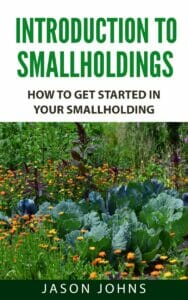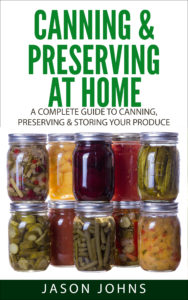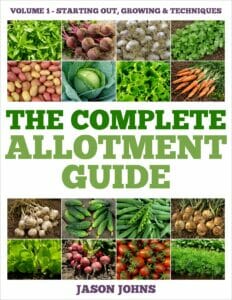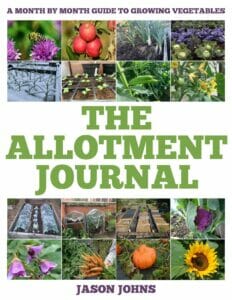In October, the allotment gets quieter, though you can find plenty to do. Sowing will be slowing down, but there is still lots of harvest and eat. Many of your plants will not survive a frost, so they need to be harvested before a frost hits. You will not be watering as much, but there is plenty of tidying up and putting parts of your plot ‘to bed’ for winter.
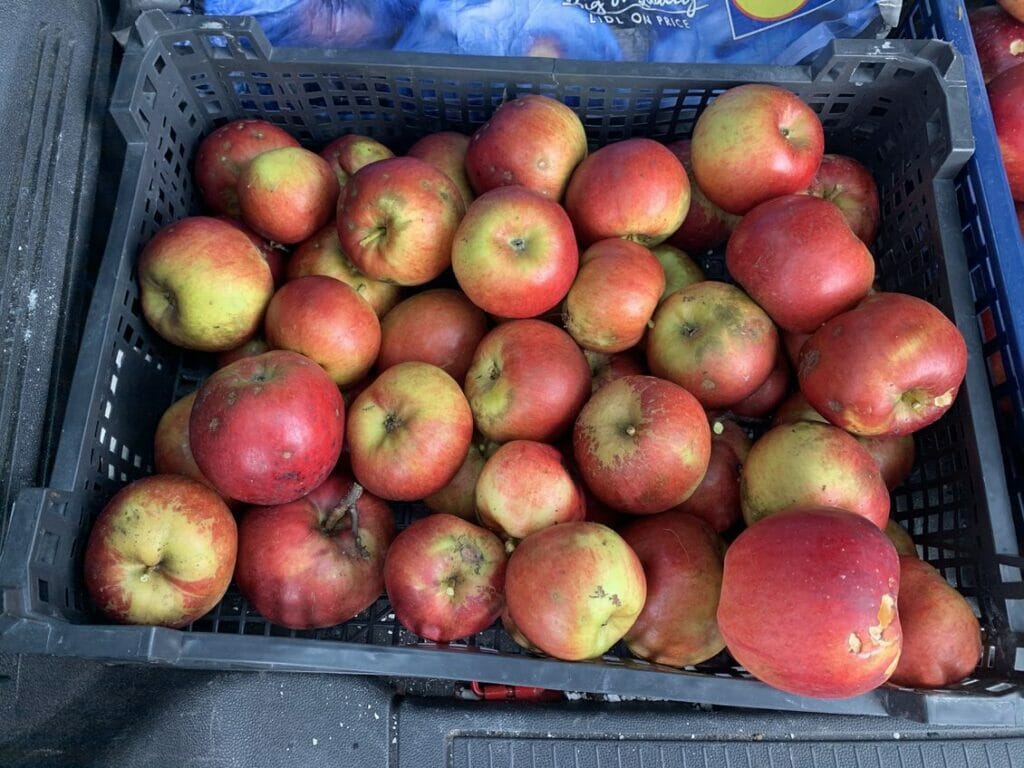
What To Harvest
Even though it is getting cooler, there is still quite a lot to harvest, though much of it will be tailing off as the month progresses. With the risk of frost increasing, many fruits will need to be harvested before the cold damages them.
- Apples – the rest of your apples should be harvested by the middle of the month. Any damaged fruit should either be discarded or used immediately, depending on what is wrong with it while the rest of the fruits can be stored or used.
- Aubergines – plants grown in your greenhouse may still be producing aubergines. Outdoor plants are likely to have finished by now.
- Beetroot – finish harvesting your beetroot before they become too large and woody.
- Broccoli – this is usually the last month for harvesting calabrese broccoli, but the sprouting varieties can crop until spring.
- Brussels Sprouts – start harvesting these before they ‘blow’ and the leaves unfurl. Harvest from the bottom of the plant up.
- Cabbages – keep these netted and start harvesting autumn cabbages.
- Cape Gooseberries – leave the berries on the plant for as long as you can as they will become sweeter. However, they need to be harvested before the first frost.
- Carrots – maincrop carrots can still be harvested this month. Providing they are not being damaged by slugs, they can be left in the ground (with the foliage cut off) for later in winter.
- Cauliflowers – continue harvesting your autumn cauliflowers this month.
- Celeriac – these should be approaching full size this month, so can be harvested when needed. For those left in the ground, remove the outer leaves around the crowns to reduce the risk of slug damage.
- Celery – harvest your celery before the frosts arrive.
- Chillies / Peppers – you may still be harvesting these from the greenhouse, though outdoor plants are unlikely to still be producing.
- Courgettes – harvest the last of the courgettes and summer squashes this month as they will be killed in the first frost
- Florence Fennel – this plant can survive light frosts, but any bulbs left in the ground will benefit from having a cloche put over them.
- French Beans – any beans dried on the plant for storage will be ready to harvest this month. Once removed from the pods, store in airtight containers.
- Grapes – mid-season grape varieties are harvested around the middle of the month whereas late-season varieties will be picked at the end of the month.
- Kohl Rabi – those sown in the summer will be ready to harvest this month.
- Leeks – harvest leeks as and when you need them.
- Lettuces – summer sown lettuces can be harvested now, though will benefit from protection from the cold.
- Marrows – some marrows may still be on the plants. Make sure they are harvested this month before the frosts, which will kill the plant.
- Parsnips – these are left in the ground until after the first frost that turns the starches into sugars, making them sweeter. Lift after the first frost and use. They can be left in the ground until needed providing they are not being damaged by pests or the ground isn’t waterlogged.
- Pears – Any pears left on the tree should be picked this month. Damaged or bruised fruit should be used immediately, whereas intact fruit can be stored.
- Peas – harvest the last of the peas before the frosts arrive.
- Plums and Gages – late ripening varieties may still have some fruit on. Damsons can be harvested this month and sloes can be picked towards the end of the month after the first frost.
- Pumpkins – pumpkins and winter squashes are harvested this month as the frosts will kill the plants. Cure them in the sun so the skin hardens and they store longer. Bring them indoors before the first frosts.
- Radishes – some may still be ready to harvest from a summer sowing. Do not leave them to grow too large as they become inedible.
- Raspberries – autumn fruiting raspberries will still be cropping and often continue to do so until the first hard frost.
- Runner beans – pick any beans left on the plant.
- Spinach – keep harvesting spinach as and when you need it. Autumn cultivars, sown in late summer, should be ready to harvest.
- Strawberries – if there are any strawberries left on the plants, harvest them before the first frost as they will not survive.
- Swede – this month, and next, swedes are at their best, so harvest them as and when you need them.
- Sweet Potatoes – dig up the last of your sweet potatoes as they will be attacked by slugs if they remain in the ground. Dry them in the sun before storing.
- Tomatoes – if the weather is mild, outdoor tomatoes may still be ripening, though you may need to bring unripe fruit indoors to ripen completely. The plants will not survive the frost.
- Turnips – lift them before they get too large, though they can be left in the ground until required providing pest aren’t damaging them.
Vegetable Garden Jobs
Most of the jobs in the vegetable garden involve tidying up and preparing for winter. This month you can sow and plant crops that don’t mind the cold such as garlic, onion sets and rhubarb too.
- Broad Beans – early varieties can be planted this month or next and should overwinter fine in most areas.
- Brussels Sprouts – keep earthing up all your brassica plants to stop them from rocking in the wind. Any yellowing leaves should be removed and composted.
- Cabbages – spring cabbages are planted out into their final position. Firm the ground down well and protect them from birds with nets.
- Chillies – outdoor chillies will die in the frosts. If you want to keep them through winter, lift them, put them in containers, prune and store in a frost free greenhouse or polytunnel over winter.
- Clay Soil – dig in manure and organic matter to help break up clay soil over winter.
- Cover Beds – any unused beds should be covered with a woven weed membrane. This allows water to penetrate through to the soil while suppressing weeds and keeping the soil warm, allowing for earlier planting in the spring.
- Garlic – garlic cloves are planted this month and next. They need cold weather to form bulbs. They will survive the winter, though they will struggle if they get waterlogged.
- Green Manure – green manures that will not overwinter need to be dug into the soil.
- Heavy Soil – break up heavy soil that has become compacted over the year.
- Jerusalem Artichokes – cut these down to just above the ground and compost the leaves.
- Leeks – earth up leeks that are left in the ground and protect from allium leaf miner with a tight weave mesh.
- Onions – overwintering onion sets can still be planted this month.
- Parsnips – mulch your parsnips with straw to protect them so they last longer in the soil.
- Peas – sow overwintering peas in a sheltered spot this month. The plants will need protecting with cloches over winter.
- Plant Supports – canes, stakes and pea sticks can all be removed, cleaned and stored under cover for use next year.
- Vegetation – remove all dead foliage and dying plants. These can be composted, providing they are not diseased.
Fruit Tree/Bush Jobs
There may still be a few apples and pears to pick, but generally, harvest time will be over in the fruit garden. There is still some work to do, but mainly it is tidying up and preparing your plants for winter.
- Currants – bare root currant bushes can be planted this month.
- Gooseberries – bare root bushes can be planted this month.
- Grapes – bare root vines can be planted this month or next, though traditionally, they are planted in March.
- Ordering – order new fruit trees and bushes for planting next month.
- Rhubarb – new plants can be put in the ground whereas old plants can be divided and re-planted.
- Strawberries – new plants can still be put in the ground, though they may not produce a large crop next year.
General Jobs
The allotment is quite quiet this month and there isn’t a lot of other jobs to do at the moment.
- Compost – turn your compost heap a couple of times this month and aerate it regularly with a fork to speed up the decomposition process.
- Digging – now is a good time to dig your allotment. Many people will turn the soil and leave it to break down over winter.
- Leaves – fallen leaves can be collected and piled in a corner of your allotment. Over the next year or two, they will break down to form leaf mould that can be used to improve your soil.
- Log Pile – build a log pile in a sheltered corner of your allotment for wildlife to shelter in over winter.
- Manure – fresh manure can be spread on beds where it will break down over winter and can be dug in sometime in early spring.
- Painting – if the weather is dry for a few days, sheds and other wooden structures could benefit from a coat of preservation paint to protect them through winter.
- Pots – empty and clean any pots that have finished for the season.
- Sheds – check that your shed is watertight. Check the roof, window and door. You may be storing some of your harvest in here over winter and you want to protect it. Make any repairs that are required.
- Water Butts – clear fallen leaves from water butts and clear gutters.
- Weeding – clear away any weeds, digging up all the young perennial weeds to prevent them from getting established.
Greenhouse and Polytunnel Jobs
Work in the greenhouse will have quietened down this month as most plants will be finished for the season. If you have a polytunnel, make sure it is securely fixed to the ground to protect it from the winter winds. So long as nothing is growing in your polytunnel, you can remove the plastic sheeting and replace it in the spring.
- Citrus Plants – move citrus plants inside as they do not tolerate frosts.
- Debris – clear any debris out of your greenhouse so that pests have nowhere to overwinter.
- Glass – check the glass is secure in its frames, replacing any damaged panels and fixings.
- Melons – melons may still be ripe this month, though the weather will be cooling too much for the plants to survive much longer, even indoors. Harvest the melons as soon as they are ripe, removing immature fruits so the larger fruits ripen.
- Microgreens – sow microgreens in your greenhouse for harvest in a few weeks.
- Onions and Garlic – these can continue to dry in the greenhouse before storing.
- Sweet Peas – start sweet peas off now to plant early in spring.
- Wash – wash the glass to remove any dirt and let as much sun as possible in.


